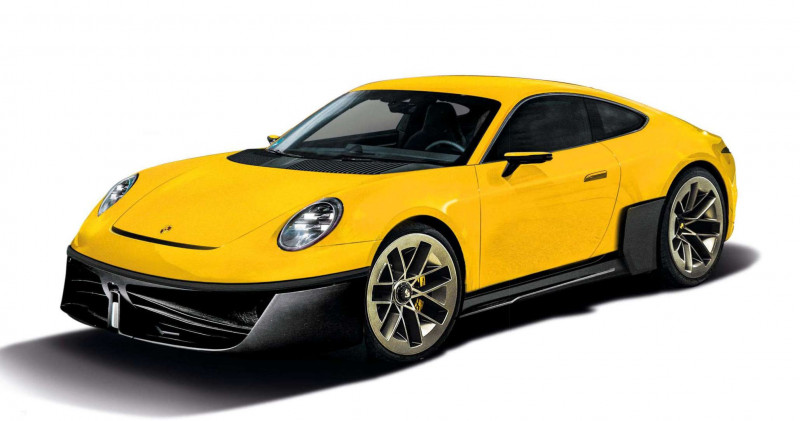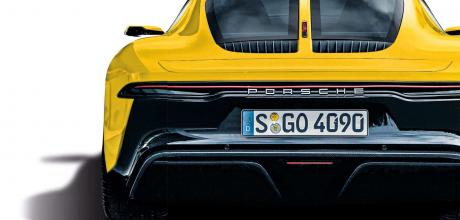Porsche’s electric 911 998
The Porsche 911 will go electric – in two giant leaps. We unveil Porsche’s plan to save its defining model. By Georg Kacher.
First we’ll see the hybrid 911, the 994, then the full-electric 998-gen car before the end of the decade. Porsche’s plan for the 911’s electrification is a bold transformation strategy – with plenty of imponderables. Like which type of battery to use, how to package it, and what shape to choose for minimum drag with maximum 911-ness. This story is a work in progress – progress that began in the last decade.
Designed with past, present and future in mind, and pacesetting in terms of its drivetrain

While we tapped a variety of sources to shed light on the means and the end, a lot can change between now and 2028. But the wheels are in motion – as they must be. As Michael Steiner, Porsche’s R&D boss puts it: ‘Deciding too early can be wrong. But deciding too late is always a mistake.’
2018 The first clues
A decade prior to its tentative due date, a mysterious red dot marked 998 made its first appearance on the top-secret product-cycle plan at Porsche’s Stuttgart HQ. This at a time when the company was making final preparations for the launch of the eighth-generation 911 (codenamed 992 and complete with mount points on the new gearbox for an e-motor) and the second Macan facelift. Even though the combustion engine was under pressure from increasingly strict emissions controls and growing social acceptance issues, European EV sales were still in single-digit percentages; the Taycan still more than a year away.
2021 If Porsche can make an electric racer…
Three years on from its first appearance on the product plan, the 998 is still there. This far out from the start of production, the cycle plan normally shows white and green clouds to underline the provisional character of the project. The 998, however, appears to be a solid programme with no asterisks or comment attached. But there’s also no official confirmation; in fact, when I steer the conversation toward that still-classified three-digit code at the IAA auto show in Munich, Dr Steiner is not amused.
But lift your eyes from secret documents to gaze at the Mission R show car, and you grasp Porsche’s confidence in its electrification capabilities.
2022-2027 The transformation
The Taycan is a huge success, its 19,822 sales in the first half of 2021 nip-and-tuck with the 911’s. Next we’ll see Porsche start to transform its familiar name plates from combustion engines to fully electric. First up is the Macan, Porsche’s biggest-selling car. The new electric- only version will be a 2023 model, Porsche has confirmed. There’ll likely be a transition period while the new EV is sold alongside the current combustion model. We’re expecting the electric Cayman and Cayenne to follow in 2024, and the Panamera in 2027 at the latest. The Taycan could be ready for a switch from the MK1’s J1 architecture to the group’s SSP platform in 2026. Expect a large super-Cayenne crossover around the same time, which shares its DNA with the Audi Grandsphere and a Bentley. These EVs will help Porsche towards its aim of CO2 neutrality by 2030 while also providing valuable data for the 998 project.
2025 Next-gen batteries
The batteries are critical to the whole project. Even the Mission R’s sophisticated high-performance cells may not be progressive enough for the second half of the decade. That’s when American firm Quantum- Scape hopes to deliver the Holy Grail: the very first high-performance solid-state energy cells. Exactly when QuantumScape can deliver its dedicated power banks is another matter. In an ideal world, hands-on work with the supercells would begin in 2025 at the latest.
Key assets of the multi-dozen-layer cells are claimed to include an 80 per cent range extension over lithium-ion, greater stability and a dramatically faster six-minute charge time from five to 80 per cent. The supplier community tells us that the Porsche specification emphasises flexible packaging for optimised weight distribution and space utilisation, as well as efficiency and high-speed robustness on road and track. And where exactly would these batteries go? Has Porsche built a prototype 911 with its rear-mounted flat-six substituted for a battery?
R&D man Steiner: ‘In CAD, yes, we did such studies. But there was never a prototype like that – too many problems [with safety; batteries need to be within the wheelbase]. We would not like to see this on the road with today’s technology. But we could split the battery, with a T-shaped layout; big battery pack behind the seats and the rest in a corridor between them.’
2026 The hybrid
The only combustion-engined Porsche that’s not part of the mid-decade switch is the 911. Expect the next-gen 994’s design to be frozen in the autumn of 2025, and production to begin at the end of 2026.
Powered by a hybrid (but not plug-in) petrol engine, the flat-six is likely to rise in capacity from 3.0 to 3.4 litres – not in pursuit of higher performance, but to compensate for the muffling effects of EU7 emissions regs.
A plug-in hybrid would mean more weight, less space, increased complexity and dynamic compromises. Porsche’s solution adds slugs of additional grunt to beef up the low- to mid-rev performance. We hear the compact e-boost system will throw in an extra 270bhp for a total output of over well over 800bhp…
Once the 994’s design is set, the same team will switch to finalising the 998, a car that will pose some big challenges for the engineers and designers who must define it.
Or will it? Perhaps an electric 911 designs itself… Head of design Michael Mauer told CAR: ‘The silhouette of today’s 911 is so iconic. That has to stay, as we have proved over the years – the new 911 is always a 911; just a new one. Listening to the engineers now, when we talk about combustion engines, the limitations, exhaust systems… Honestly, I am more worried about how we’d package this in 10 or 15 years’ time because most likely the overhang would be almost two metres…
‘Electric technology brings more freedom but yes, the Cayman and Boxster are mid-engined and the 911 is rear-engined, and we have to make sure these cars are differentiated. We’re going to see. We can make it work.’ 2028 They said it couldn’t be done…
The date may shift a little. Something might change in the wider world of emissions regulations, battery supply, charging networks and indeed global pandemics. But if all goes to plan, as we understand it, then in 2028 the 998 – the 100 per cent electric 911 – will arrive.
Developed from scratch, designed with the past, present and future in mind and pace-setting in terms of drivetrain and batteries, it promises to be a revolutionary concept wrapped in an evolutionary skin. Can we expect a car a little like a larger and more potent Cayman EV derivative? Or something on a new architecture conceived around SSP, the VW Group’s performance EV platform?
All these ideas are in the mix. The Weissach grapevine reports that the scalable platform principle will be complemented by bespoke modules. There could be two different underbodies, shaped for more and less ground effect, and interchangeable uppers defining the character and style of the individual models. Think Spyder, Speedster, Sahara, Sportster… The challenges are vast, not least because the e-drivetrain will occupy more space than a combustion engine and its fuel tank. Then there’s the battery-induced weight disadvantage… But Porsche has shown a formidable ability to rise to challenges.
‘A real sports car has to perform on the racetrack, and there the car’s lateral capabilities [its ability to hustle corners] are at least as important as longitudinal [its acceleration]. Maybe even more important,’ muses Dr Steiner. ‘When electric cars become superior to combustion-engined cars – and this will happen by the end of the decade – then there will be more and more customers willing to switch concepts.’
When that time comes the 911 will be ready.
Challenges include making it look and feel different from e-Cayman. Our illustration is clearly a 911, but not one with a boxer engine.
KEEP YOUR MOTOR RUNNING
Porsche’s engines will keep running for a good few years yet, helped by a Porsche/Siemens project to produce synthetic fuel – which they call eFuel – that isn’t based on fossils and produces negligible CO2. Work has begun on a plant in Chile that by 2030 will produce 550 million litres of eFuel a year.
Initially it will be used in the Porsche Supercup race series, and at Porsche Experience Centres. It might be made available to other manufacturers, and even F1, depending on the details of a distribution system yet to be mapped out.
Chile is particularly well suited to the creation of eFuel thanks to its strong, consistent winds, which provide a CO2-neutral way of powering the process in which usable hydrogen is extracted from water for conversion into fuel.
But don’t think this means a long-term reprieve for combustion engines.
Michael Steiner, Porsche’s R&D chief, says: ‘Our main strategy is e-mobility, but to be CO2-neutral by 2030 we need additional measures. We see this as an important additional measure and as a role model that could be feasible for on-road, offroad transportation, but also shipping, maybe aviation.
‘This is no competition to e-mobility. Wherever you have renewable electricity in the grid, it’s always more efficient to just drive with this electricity.’


